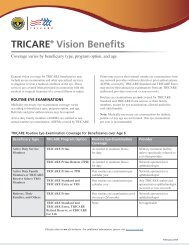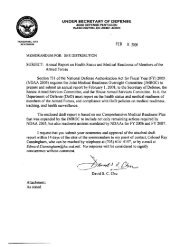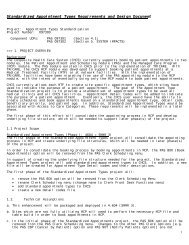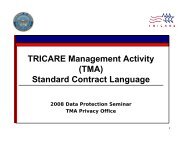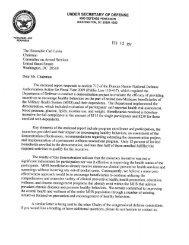Medical Management Guide, 2009, Version 3.0 - Tricare
Medical Management Guide, 2009, Version 3.0 - Tricare
Medical Management Guide, 2009, Version 3.0 - Tricare
- No tags were found...
You also want an ePaper? Increase the reach of your titles
YUMPU automatically turns print PDFs into web optimized ePapers that Google loves.
Page 106Disease <strong>Management</strong> <strong>Version</strong> <strong>3.0</strong><strong>Medical</strong> <strong>Management</strong> <strong>Guide</strong>are at risk for exacerbating or complicating theirdisease.In the Department of Defense (DoD), MTFs havesuccessfully implemented DM programs for anumber of conditions and disease states. Inaccordance with the National Defense AuthorizationAct (NDAA) of 2007, the Military Health System(MHS) was tasked with developing DM programsfor a variety of diseases and chronic conditionsincluding asthma, chronic obstructive pulmonarydisease, diabetes, depression and anxiety disorders,cancer, and heart disease. Thus, MTFs and ManagedCare Support Contractors (MCSCs) have begun tosystematically incorporate these disease states intotheir DM programs.system of coordinated healthcare interventions andcommunications for populations with conditions inwhich patient self-care efforts are significant.”The DMAA has broadened its focus from strictlyDM to a Population Health model, of which DMis a component. This model promotes a proactive,accountable, patient-centric approach featuring a“physician-guided” healthcare delivery approachdesigned to “develop and engage informed andactivated patients over time to address both illnessand long term health” (DMAA, <strong>2009</strong>). The MHSPopulation Health model (see Section I, <strong>Medical</strong><strong>Management</strong> Essentials, Fig. 3) is based on ahealthcare delivery approach that incorporates sixkey components illustrating this paradigm from aprovider-guided approach.Definition, Goals, and PurposeDM is an organized effort aimed at achievingdesired health outcomes in populations withprevalent, often chronic, diseases for whichhealthcare delivery may be subject to considerablevariation (Kongstvedt, 2007) (see also Appendix C,Definitions). In contrast to CM’s focus on individualpatients, DM is aimed at sub-populations of patientswith a specific condition, disease, or set of comorbidities(e.g., the metabolic syndrome associatedwith diabetes, hypertension, and hyperlipidemia).The principles of DM are applicable to all venuesof healthcare delivery, including the inpatient andoutpatient settings in both the primary and specialtycare arenas.According to the Disease <strong>Management</strong> Associationof America (DMAA, <strong>2009</strong>): The Care ContinuumAlliance (hereafter referred to as DMAA), DM is “aDM program goals are to improve clinical outcomes,increase patient and provider satisfaction, andpromote appropriate utilization of resourcesthroughout the MHS. The purpose of DM isto improve the quality of life for individuals bypreventing or minimizing the impact of a disease orchronic condition. This purpose is accomplished byactivities such as implementing more standardizedcare and improving patients’ ability to care forthemselves.Per the DMAA (<strong>2009</strong>), a DM program:• Emphasizes prevention of exacerbations andcomplications by using evidence-based practiceguidelines and patient empowerment strategies.• Supports the healthcare provider/patient relationshipand plan of care.• Evaluates clinical, humanistic, and economicoutcomes on an ongoing basis with the goal ofimproving overall health.



